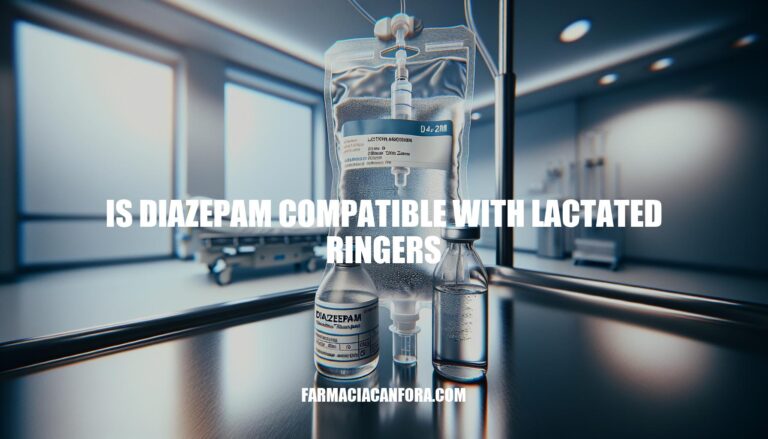


Understanding the compatibility of diazepam with lactated Ringer’s solution is crucial in medical settings. Diazepam, a benzodiazepine used for anxiety, seizures, and muscle spasms, often requires intravenous administration. Lactated Ringer’s solution, commonly used for fluid resuscitation, must be compatible with diazepam to ensure safe and effective treatment. Compatibility affects the stability and efficacy of the medication, preventing adverse reactions and ensuring patient safety.
Diazepam is a benzodiazepine with the chemical formula
. It is very slightly soluble in water, soluble in alcohol, and freely soluble in chloroform. In aqueous solutions, diazepam is relatively stable at pH 4-8, with maximum stability around pH 5. It is sensitive to hydrolytic and photolytic degradation, particularly under neutral and alkaline conditions.
Lactated Ringer’s solution is an isotonic fluid with an osmolarity of 273 mOsm/L and a pH of approximately 6.5. It contains sodium chloride, sodium lactate, potassium chloride, and calcium chloride. The lactate in the solution is metabolized into bicarbonate by the liver, which can help correct metabolic acidosis.
When mixed:
Overall, diazepam can be mixed with Lactated Ringer’s solution if diluted properly (at least 1:40) and used within a specific timeframe (6-24 hours) to maintain stability and potency.
Several clinical studies have investigated the compatibility of diazepam with lactated Ringer’s solution:
Stability and Compatibility Study: This study found that diazepam is stable when diluted in lactated Ringer’s solution to a ratio of at least 1:40 and used within 6 hours, or to a ratio of 1:50 and used within 24 hours.
Incompatibility in Plastic IV Bags: Another study observed no visual incompatibilities over a 24-hour period when diazepam was diluted in lactated Ringer’s solution. The pH remained stable, ranging from about 5.0 to 6.0.
General Compatibility: It is generally recommended that diazepam be diluted in lactated Ringer’s solution, among other solutions, for infusion purposes, maintaining the same dilution ratios and usage times as mentioned above.
These studies conclude that diazepam can be safely diluted in lactated Ringer’s solution under specific conditions, ensuring stability and compatibility for clinical use.
The compatibility of diazepam with lactated Ringer’s solution has significant practical implications for healthcare providers:
Drug Stability: Diazepam is known to be unstable in plastic containers and administration sets, leading to a significant loss of potency over time. This means that if diazepam is to be administered with lactated Ringer’s solution, it should ideally be stored in glass containers to maintain its effectiveness.
Administration Practices: When using plastic administration sets, it’s crucial to avoid those with burette chambers, as they can cause a substantial reduction in diazepam’s potency. Inline filters (0.45 micron) can be used without affecting the drug’s potency.
Clinical Decision-Making: Understanding these compatibility issues helps healthcare providers make informed decisions about drug administration routes and storage methods, ensuring that patients receive the correct dosage and effective treatment.
Patient Safety: Proper handling and administration of diazepam with lactated Ringer’s solution can prevent medication errors and ensure that patients receive the intended therapeutic effects, enhancing overall patient care and safety.
By adhering to these guidelines, healthcare providers can optimize the efficacy of diazepam treatments and improve patient outcomes.
Diazepam, a benzodiazepine used for anxiety, seizures, and muscle spasms, requires intravenous administration and must be compatible with lactated Ringer’s solution to ensure safe and effective treatment.
The compatibility of diazepam with lactated Ringer’s solution is crucial in medical settings, affecting the stability and efficacy of the medication. Diazepam is relatively stable at pH 4-8, but sensitive to hydrolytic and photolytic degradation, particularly under neutral and alkaline conditions.
Lactated Ringer’s solution has a pH of approximately 6.5 and contains sodium chloride, sodium lactate, potassium chloride, and calcium chloride. When mixed, diazepam can precipitate due to poor water solubility, but the slightly acidic pH of lactated Ringer’s can mitigate this degradation.
Clinical studies have investigated the compatibility of diazepam with lactated Ringer’s solution, concluding that it is stable when diluted in a ratio of at least 1:40 and used within 6-24 hours.
Healthcare providers must adhere to specific guidelines for drug administration routes and storage methods to ensure patient safety and prevent medication errors. Understanding the compatibility of diazepam with lactated Ringer’s solution is essential in medical practice, optimizing the efficacy of treatments and improving patient outcomes.